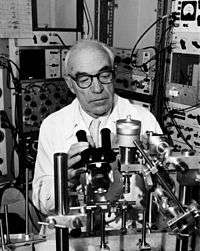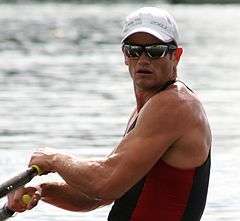University of Otago
|
Māori: Te Whare Wānanga o Otāgo | |
 | |
| Motto | Latin: Sapere aude |
|---|---|
Motto in English | Dare to be wise |
| Type | Public |
| Established | 1869 |
| Chancellor | Dr Royden Somerville QC |
| Vice-Chancellor | Harlene Hayne |
Administrative staff | 3,788 (2014)[1] |
| Students | 20,942 (2014)[1] |
| Undergraduates | 15,635 (2014)[1] |
| Postgraduates | 4,378 (2014)[1] |
| 1,388 (2014)[1] | |
| Location |
Dunedin, Otago, New Zealand 45°51′56″S 170°30′50″E / 45.86556°S 170.51389°ECoordinates: 45°51′56″S 170°30′50″E / 45.86556°S 170.51389°E |
| Campus | Urban |
| Student Magazine | The Critic[2] |
| Colours | Blue and gold |
| Affiliations | MNU |
| Website | https://www.otago.ac.nz |
 | |
The University of Otago (Māori: Te Whare Wānanga o Otāgo) is a collegiate university located in Dunedin, Otago, New Zealand. It scores highly for average research quality, and in 2006 was second in New Zealand only to the University of Auckland in the number of A-rated academic researchers it employs.[3] In the past it has topped the New Zealand Performance Based Research Fund evaluation.[4]
The university was created by a committee led by Thomas Burns,[5] and officially established by an ordinance of the Otago Provincial Council in 1869.[6] The university accepted its first students in July 1871, making it the oldest university in New Zealand and third-oldest in Oceania. Between 1874 and 1961 the University of Otago was a part of the federal University of New Zealand, and issued degrees in its name.
Otago is known for its vibrant student life, particularly its flatting, which is often in old houses. Otago students (Scarfies) have a long standing tradition of naming their flats.[7] The nickname "Scarfie" comes from the habit of wearing a scarf during the cold southern winters.[8] The university's graduation song, Gaudeamus igitur, iuvenes dum sumus ("Let us rejoice, while we are young"), acknowledges students will continue to live up to the challenge, if not always in the way intended.
The architectural grandeur and accompanying gardens of Otago University led to it being ranked as one of the world's most beautiful universities by the British publications The Daily Telegraph and The Huffington Post.[9][10]
History


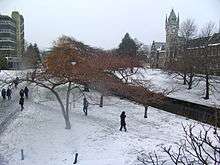
The Otago Association's plan for the European settlement of southern New Zealand, conceived under the principles of Edward Gibbon Wakefield in the 1840s, envisaged a university.
Dunedin leaders Thomas Burns and James Macandrew urged the Otago Provincial Council during the 1860s to set aside a land endowment for an institute of higher education.[11] An ordinance of the council established the university in 1869, giving it 100,000 acres (400 km2) of land and the power to grant degrees in Arts, Medicine, Law and Music.[12] Burns was named Chancellor but he did not live to see the university open on 5 July 1871.[5][11]
The university conferred just one degree, to Alexander Watt Williamson, before becoming an affiliate college of the federal University of New Zealand in 1874. With the dissolution of the University of New Zealand in 1961 and the passage of the University of Otago Amendment Act 1961, the university resumed its power to confer degrees.[12]
Originally operating from William Mason's Post Office building on Princes Street, it relocated to Maxwell Bury's Clocktower and Geology buildings in 1878 and 1879.[12] This evolved into the Clocktower complex, a striking group of Gothic revival buildings at the heart of the campus. These buildings were inspired by then-new main building at Glasgow University in Scotland.
Otago was the first university in Australasia to permit women to take a law degree.[13] Ethel Benjamin graduated LLB in 1897. Later that year she became the first woman in the British Empire to appear as counsel in court.[14]
Professor Robert Jack made the first radio broadcast in New Zealand from the physics department on 17 November 1921.[15]
Queen Elizabeth II visited the university library with the Duke of Edinburgh on 18 March 1970. This was the first time the royals completed informal “walkabouts” to meet the public, and it was the first visit of Prince Charles (then 21 years old) and Princess Anne (19 years) to this country.[16]
Because it had a wide range of courses, Otago attracted more students from outside its provincial district. This led to the growth of colleges and informal accommodation in north Dunedin around the faculty buildings. This development of a residential campus gave Otago a more vibrant undergraduate student life at the same time as comparable but smaller developments in Christchurch, Wellington and Auckland were eclipsed in the late 20th century. Otago now has the most substantial residential campus of any university in New Zealand or Australia, although this is not without its problems.
In May 2010 University joined the Matariki Network of Universities (MNU) together with Dartmouth College (US), Durham University (UK), Queen’s University (Canada), University of Tübingen (Germany), University of Western Australia (Australia) and Uppsala University (Sweden).[17]
Coat of arms
The blazon of the arms granted by the Lyon King of Arms, Scotland is Azure, on a saltire cantoned between four mullets of six points Or, a book, gilt-edged and bound in a cover Gules charged with a mullet of six points of the second and a book-marker of the third issuance from the page-foot, and in an Escrol under the same this Motto "Sapere Aude".
The motto may be translated as 'dare to be wise' or 'have courage to be wise'. The shield is first described and it is blue (azure.) On the shield is a saltire which is an “X” shaped object. On the saltire sits a gilt edged book the cover of which is red (gules.) On the cover of the book is a star (mullet) of six points. Mullets normally only have five points. At the foot of the book is a bookmark also in red being the third colour mentioned. The saltire and the book are surrounded by four other stars each also of six points which are placed in the spaces formed by the saltire. The five stars and the saltire are all coloured gold (or) which was the second colour mentioned. An Escrol is the scroll under the shield containing the motto.
Divisions


The university is divided into four academic divisions:
- Division of Humanities
- Division of Health Sciences
- Division of Sciences
- School of Business
For external and marketing purposes, the Division of Commerce is known as the School of Business, as that is the term commonly used for its equivalent in North America. Historically, there were a number of schools and faculties, which have now been grouped with stand alone departments to form these divisions.
In addition to the usual university disciplines, the University of Otago Medical School (founded 1875) is one of only two medical schools in New Zealand (with component schools in Dunedin, Christchurch and Wellington); and Otago is the only university in the country to offer training in Dentistry. Other professional schools and faculties not found in all New Zealand universities include Pharmacy, Physical Education, Physiotherapy, Medical Laboratory Science, and Surveying. It was also home to the School of Mines, until this was transferred to the University of Auckland in 1987. Theology is also offered, traditionally in conjunction with the School of Ministry, Knox College, and Holy Cross College, Mosgiel.
There are also a number of service divisions including:
- External Engagement Division
- Financial Services Division
- Human Resources Division
- Information Technology Services Division
- Property Services Division
- Research & Enterprise Division
- Student Services Division
Students
| Enrolment By Qualification Type[18] | 2016 | 2015 | 2014 | 2013 | 2012 | 2011 | 2010 | 2009 | 2008 | 2007 | 2006 | 2005 | 2004 | 2003 |
|---|---|---|---|---|---|---|---|---|---|---|---|---|---|---|
| Doctoral | 1,411 | 1,387 | 1,389 | 1,361 | 1,377 | 1,259 | 1,258 | 1,206 | 1,104 | 1,048 | 935 | 829 | 755 | 723 |
| Masters’ | 1,287 | 1,224 | 1,214 | 1,216 | 1,281 | 969 | 979 | 921 | 874 | 838 | 1,052 | 1,108 | 1,060 | 994 |
| Postgraduate Diplomas and Certificates | 1,654 | 1,542 | 1,388 | 1,383 | 1,477 | 1,541 | 1,660 | 1,620 | 1,566 | 1,435 | 1,507 | 1,378 | 1,353 | 1,345 |
| Graduate Diplomas | 294 | 314 | 388 | 416 | 426 | 475 | 487 | 405 | 317 | 494 | 204 | 392 | 314 | 298 |
| Bachelors’ with Honours | 385 | 451 | 434 | 460 | 524 | 873 | 854 | 843 | 723 | 750 | 736 | 769 | 771 | 763 |
| Bachelors’ Ordinary | 14,598 | 14,559 | 15,136 | 15,489 | 15,762 | 15,593 | 15,780 | 15,359 | 13,347 | 13,136 | 12,868 | 12,939 | 12,711 | 12,186 |
| Undergraduate Diplomas and Certificates | 29 | 39 | 65 | 73 | 92 | 116 | 152 | 169 | 133 | 265 | 216 | 239 | 318 | 344 |
| Certificate of Proficiency | 1,493 | 1,442 | 1,284 | 1,228 | 1,171 | 1,326 | 1,450 | 1,419 | ? | ? | ? | ? | ? | ? |
| Interest Only | 1 | 4 | 10 | 0 | 0 | ? | 223 | 150 | ? | ? | ? | ? | ? | ? |
| Foundation Studies | 292 | 316 | 300 | 303 | 266 | 254 | 273 | 282 | ? | ? | ? | ? | ? | ? |
| Total | 20,814 | 20,601 | 20,942 | 21,113 | 21,416 | 21,728 | 22,139 | 21,507 | 20,752 | 20,665 | 19,853 | 20,057 | 19,674 | 18,844 |
| Ethnicity of Students[19] | 2016 | 2015 | 2014 | 2013 | 2012 | 2011 | 2010 | 2009 | 2008 | 2007 | 2006 | 2005 | 2004 |
|---|---|---|---|---|---|---|---|---|---|---|---|---|---|
| European/Pākehā | 73.1% | 73.4% | 74.3% | 74.3% | 74.8% | 75.0% | 75.6% | 75.7% | 76.8% | 68.4% | 68.3% | 69.1% | 69.5% |
| Māori | 8.9% | 8.5% | 8.5% | 8.0% | 7.8% | 7.6% | 7.6% | 7.5% | 7.3% | 6.9% | 6.4% | 6.2% | 6.1% |
| Asian | 19.2% | 18.8% | 18.3% | 18.6% | 18.3% | 17.9% | 17.2% | 16.9% | 16.0% | 15.6% | 16.5% | 16.1% | 15.2% |
| Pacific Islanders | 4.2% | 3.9% | 3.6% | 3.2% | 3.1% | 3.1% | 3.1% | 3.0% | 2.8% | 2.6% | 2.6% | 2.5% | 2.5% |
| Other / unknown | 3.7% | 3.6% | 3.2% | 3.3% | 2.9% | 2.9% | 2.5% | 5.3% | 4.4% | 6.5% | 6.2% | 6.1% | 6.6% |
Campuses
In addition to the main Dunedin campus, the university has small facilities in Auckland and Wellington (based at the Wellington Centre).[20] The medical schools have larger campuses near Christchurch and Wellington Hospitals. Additionally, the university has the Portobello Marine Laboratory inside Otago Harbour.
- Merger with Dunedin College of Education
The University and the Dunedin College of Education (a specialist teacher training institution) merged on 1 January 2007. The University of Otago College of Education is now based on the College site, and includes the College's campuses in Invercargill and Alexandra. Staff of the University's Faculty of Education relocated to the college site. A merger had been considered before, however the present talks progressed further, and more amicably, than previously.
Libraries
.jpg)
The University of Otago has ten libraries: seven based in Dunedin on the main university campus, the education library in Southland, plus two medical libraries in Wellington and Christchurch.[21] All libraries have wireless access.[22]
The Central Library is part of the Information Services Building and has over 2000 study spaces, 130 computer terminals, and laptop connections at 500 desks. It has Te Aka a Tāwhaki, a collection of Māori resources,[23] and the Special Collections consisting of about 9,000 books printed before 1801. In total, the Central Library has over 800,000 print and electronic materials relating to the arts and humanities, commerce, education, physical education, social sciences, and technology.[24] It was designed by the American architecture firm Hardy Holzman Pfeiffer and opened in 2001, replacing what was previously a 1960s-era modernist building.
The Health Sciences Library is in the Sayers Building, opposite the main entrance to Dunedin Hospital. The Health Sciences Library book collection only includes the last 10 years of content, but does have over 150,000 volumes, the vast majority of which are in storage. There is seating for over 400.
The Science Library is at the north end of the campus in the Science III building, with seating for approximately 500.
The Hocken Collections is a research library, archive, and art gallery of national significance which is administrated by the University of Otago. The library's specialist areas include items relating to the history of New Zealand and the Pacific, with specific emphasis on the Otago and Southland regions. The Hocken Collections was established in 1910 when Dunedin philanthropist Thomas Hocken donated his entire private collection to the University of Otago. It currently houses over 8,000 linear metres of archives and manuscripts. It is currently situated at the site of the former Otago Co-operative Dairy Company factory on Anzac Avenue, east of the main campus.[24][25]
The Robert Stout Law Library is the university's law library and is based in the Richardson Building.[26] The Robertson Library is the university's education library and is jointly run by the University of Otago's College of Education and Otago Polytechnic, which is also located near the university's Dunedin campus.[27]
Distinctions
Many Fellowships add to the diversity of the people associated with "Otago". They include:
- Robert Burns Fellowship (literature)
- Caroline Plummer Fellowship in Community Dance
- Charles Hercus Fellowship
- Claude McCarthy Fellowship
- Foxley Fellowship
- Frances Hodgkins Fellowship (art)
- Henry Lang Fellowship
- Hocken Fellowship
- James Cook Fellowship
- Mozart Fellowship (music)
- THB Symons Fellowship
- William Evans Visiting Fellowship
In 1998, the physics department gained some fame for making the first Bose–Einstein condensate in the Southern Hemisphere.
The 2006 Government investigation into research quality (to serve as a basis for future funding) ranked Otago the top University in New Zealand overall, taking into account the quality of its staff and research produced. It was also ranked first in the categories of Clinical Medicine, Biomedical Science, Law, English Literature and Language, History and Earth Science. The Department of Philosophy received the highest score for any nominated academic unit. Otago had been ranked fourth in the 2004 assessment.
In 2006, a report released by the Ministry of Research, Science and Technology found that Otago was the most research intensive university in New Zealand, with 40% of staff time devoted to research and development.[3]
Journal "Science" has recommended worldwide study of Otago's Biochemistry database "Transterm", which has genomic data on 40,000 species.[28]
Academic rankings
| University rankings | |
|---|---|
| Global | |
| ARWU World[29] | 301-400 |
From 2010–2011, Times Higher Education produces rankings independently from Quacquarelli Symonds (QS). Initially this ranking was only the top 200 listed universities and the University of Otago did not appear. In 2015, the University of Otago became the first New Zealand university to have a course in a QS Top 10 list, being ranked 8th in Dentistry.[30]
| World university rankings | |||
|---|---|---|---|
| Quacquarelli Symonds (QS)[31][32] | Academic Ranking of World Universities | Times Higher Education | |
| 2015 | 173 | 201–300 | 201–250 |
| 2014 | 159 | 201–300 | 251–275 |
| 2013 | 155 | 201–300 | 226–250 |
| 2012 | 133 | 201–300 | 226–250 |
| 2011 | 130 | 201–300 | 201–225 |
| 2010 | 135 | 201–300 | 200+ |
| 2009 | 125 | 201–302 | NA |
| 2008 | 124= | 201–302 | NA |
| 2007 | 114= | 305–402 | NA |
Residential colleges
The University of Otago owns, or is in affiliation with, fourteen residential colleges, which provide food, accommodation, social and welfare services. Most of these cater primarily for first year students, though some have a sizable number of second and higher year undergraduates, as well as occasionally a significant postgraduate population. While some teaching is normally undertaken at a college, this generally represents a small percentage of a resident's formal tuition.
Most colleges actively seek to foster a sense of community and academic achievement amongst their members through, variously, intercollegiate competitions, communal dining, apartment groups, traditionalism, independent students' clubs, college events and internal sporting and cultural societies.
The colleges are geographically spread over the Dunedin urban area:
Student life
O-Week

'O-Week' or Orientation Week is the Otago equivalent of Freshers' Week. New students are most commonly known by their seniors as 'freshers' or simply as 'first-years'. O-week is organised by the Otago University Students' Association and involves competitions such as 'Fresher of the Year' whereby several students volunteer to carry out a series of tasks throughout the week before being voted to win. Other competitions include that of different faculties facing off with each other. The OUSA also organises events each night including various concerts, a comedy night, hypnotist plus bigger events at Forsyth Barr Stadium. Typically there is a Highlanders rugby game scheduled during the week. Local bars organise events also with a range of live music and promotional deals. Historically events have included the Cookathon and a Miss O-Week competition hosted by The Outback.[33] The Cookathon was held by a local pub (the Cook) with the premise that your first drink costs you about $20 which gives you a t-shirt, three meal vouchers and reduced price on drinks then you spend the rest of the day binge drinking and 'telephoning' the occasional jug with mates.[34]
- Traditions
Each year the first years are encouraged to attend the toga parade and party dressed in white sheets wrapped as togas. Retailers called for an end of the parade after property damage and disorder during the 2009 event.[35] However, the OUSA took it upon themselves to reintroduce this tradition, with a festival like event taking place at the stadium. 2012 Toga Party saw an unofficial world record. A clocktower race also occurs, in the style of Chariots of Fire. Students must race round the tower and attached building, beginning on the first chime of the clock at noon and completing before the chimes cease. Unlike Chariots of Fire, the task is possible with a couple of students completing each year.
Behavioural issues
Student behaviour is a major concern for both the University administration and Dunedin residents in general. Concerns over student behaviour prompted the University to introduce a Code of Conduct (CoC) which its students must abide by in 2007. The introduction of the CoC was accompanied by the establishment of the dedicated 'Campus Watch' security force to keep tabs on crime and anti-social behaviour on campus and in the student neighbourhoods nearby. Campus Watch reports directly to the University's Proctor.
- Riots
Riots took place in 2006, 2007, 2008 and 2009 related to events surrounding the Undie 500 car rally organised by students from Canterbury University. Other student social events during the year such as the Toga Parade and the Hyde Street Keg Race are also notable for attracting police attention, but not to the scale of the Undie riots. In 2012 there were 80 people treated by emergency services and 15 arrests by police after the Hyde Street party went out of control.[36][37]
- Protest
Otago students are notable for protesting contentious political issues in nearly every decade. In the 1960s students at Otago who were involved with the Progressive Youth Movement led protests against the Vietnam War. In the 1970s mixed flatting (males and females were prohibited from sharing housing up to that time) was contested in various creative ways by Otago students.[38] On 28 September 1993 Otago students protested against a fee increase at the University Registry (Clocktower Building), which ended in a violent clash with police.[39] In the lead up to the 1996 general election students trying to stop a 25% fee increase occupied the University Registry (Clocktower Building) for over a week (which was followed by similar occupations at campuses around the country), fee increases were limited to 17%.[40] Since 2004, the Otago University NORML club has met weekly on the Otago campus to protest by smoking cannabis in defiance of New Zealand's cannabis laws. In 2008, several members were arrested and issued trespass notices from the Union Lawn.[41][42][43]
Notable people
Faculty
- Muriel Bell, nutritionist and medical researcher
- Robert J. T. Bell, mathematician
- William Noel Benson, geologist
- Carolyn Burns, Marsden Medal winning zoologist
- Alice Copping, nutritionist
- Alison Cree, herpetologist
- Michael Cullen, politician
- Catherine Day, biochemist
- John Carew Eccles, medical researcher
- Jim Flynn, intelligence researcher and political philosopher
- David Harris, software developer
- Keith Hunter, Marsden Medal winning marine chemist
- Christina Hulbe, Antarctic researcher, glaciologist
- Robert Jack, physicist
- Pat Langhorne, physicist
- J. L. Mackie, philosopher
- Brian John Marples (1907–1967), Professor of Zoology 1937–1967[44]
- Alan Musgrave, philosopher of science
- Lisa Matisoo-Smith, Professor of Biological Anthropology and Head of the Department of Anatomy
- Christina Riesselman, paleoceanographer
- Abigail Smith, professor in marine sciences[45]
- Rachael Taylor
Alumni
(with residential college, if any, in parentheses where known)

- Rui Maria de Araújo, Prime Minister of Timor-Leste.
- Arthur Henry Adams, journalist and writer
- Muriel Bell, nutritionist and medical researcher
- Annette Baier, moral philosopher
- Barbara Anderson, novelist
- David Benson-Pope, politician
- Dame Silvia Cartwright, Governor General
- David Cunliffe (Carrington), politician
- Brian Christie, neuroscientist
- Nathan Cohen, world champion and Olympic champion rower
- Thomas Davis, politician, diplomat and researcher
- Glen Denham, Tall Black
- Derek Denny-Brown
- Archibald Durward FRSE, anatomist
- Marc Ellis (University College), All Black

- Bill English (Selwyn), 39th Prime Minister of New Zealand
- Janet Frame, writer
- Ian Fraser, broadcaster
- William Fyfe, geochemist
- Jon Gadsby, comedian and actor
- John Gallas, poet and educator
- Sir Malcolm Grant (Selwyn), lawyer and Vice-Chancellor of University College London (2003-13); subsequently Chairman of NHS England and Chancellor of the University of York
- Stephen Guest, legal academic
- Graeme Hart, businessman
- Volker Heine, physicist
- Jan Hellriegel, singer/songwriter
- Stella Maxwell, fashion model
- Greg Henderson, cyclist
- Brent Hodge (Cumberland), director
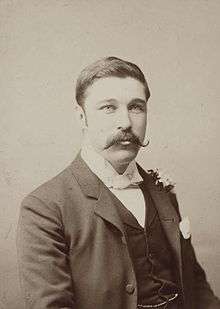
- Fergus Hume, novelist
- David Kirk (Selwyn), All Black captain and businessman
- Josh Kronfeld (Aquinas College), All Black
- Chris Laidlaw, All Black and politician
- Michael Laws, (Arana) politician, writer, broadcaster
- Tania Lineham, science teacher, winner of the Prime Minister’s Science Teacher Prize, 2015
- John Edward "Jack" Lovelock, athlete
- Chris Mahony, World Bank professional, University of Oxford doctorate, athlete
- Kamisese Mara (Knox), politician
- Archibald McIndoe, plastic surgeon
- Dame Judith Mayhew Jonas, businesswoman
- Joseph William Mellor, chemist
- Arnold Nordmeyer, politician
- Christopher Norton, composer
- Anton Oliver (University College), Captain of the All Blacks
- Prof. Datuk Dr. Mazlan Othman, astrophysicist, Director of the United Nations Office for Outer Space Affairs
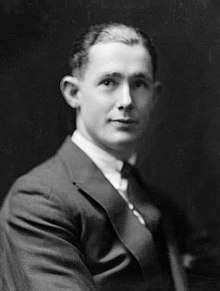
- Lord Porritt (Selwyn), Olympian, physician to the Queen and Governor General
- Arthur Prior, philosopher
- Robert Stout (Aquinas), Prime Minister of New Zealand
- Lauren Kim Roche, physician and author
- Sulaiman Daud, politician
- Peter Tapsell, politician
- Jeremy Waldron, legal philosopher
- Murray Webb, cricketer and caricaturist
- Bridget Williams, publisher
- Allan Wilson, molecular biologist
- Christine Jensen Burke, mountain climber
Rhodes Scholars

(College at Oxford in brackets)(Source: List of NZ Rhodes Scholars)1 two of Dan Davin's novels are set at Otago University.
|
|
See also
- Capping Show
- List of Honorary Doctors of the University of Otago
- Norman Edson
- Otago University AFC
- Otago University Debating Society
- Otago University Rowing Club
- Otago University NORML
- Scarfies
- University of Otago Wellington School of Medicine
- University of Otago Christchurch School of Medicine
- University of Otago Faculty of Dentistry
- University of Otago Faculty of Law
References
- 1 2 3 4 5 "Quick Statistics about the University of Otago".
- ↑ Cate Broughton; Hamish McNeilly (22 May 2018). "Destruction of period magazine 'censorship'". Stuff. Retrieved 22 May 2018.
- 1 2 Research and Development in New Zealand: A Decade in Review. (2006) Ministry of Research, Science and Technology.
- ↑ "Media release: Performance-based Research Fund results". Tertiary Education Commission. Archived from the original on 8 September 2007. Retrieved 4 July 2007.
- 1 2 King, Michael (2003). Penguin History of New Zealand. p. 209. ISBN 0-14-301867-1.
- ↑ "Our History". www.otago.ac.nz. University of Otago. Retrieved 6 September 2016.
- ↑ Chilton-Towle, Jonathan (3 March 2014). "Discovering stories behind flat names". Otago Daily Times.
- ↑ Secker, Nathan. "Scarfie Flats". Te Ara – The Encyclopedia of New Zealand. Retrieved 10 October 2012.
- ↑ "Otago University in New Zealand - Beautiful universities around the world". The Daily Telegraph (UK). 16 August 2012. Retrieved March 25, 2016.
- ↑ "World's most beautiful universities". Huffington Post (UK). 2012. Retrieved 25 March 2016.
- 1 2 McLintock, A. H. (ed) (1966). "Burns, Thomas". Te Ara – The Encyclopedia of New Zealand. Retrieved 20 September 2008.
- 1 2 3 "History of the University of Otago". University of Otago. Archived from the original on 11 April 2008. Retrieved 20 September 2008.
- ↑ "Ethel Rebecca Benjamin". New Zealand Ministry for Culture and Heritage. Retrieved 20 September 2008.
- ↑ Mayhew, Judith (4 September 2001). "5th Annual Ethel Benjamin Commemorative Address". New Zealand Law Society. Retrieved 1 October 2007.
- ↑ "Dashing heroes of a harbour crossing". Otago Daily Times. 6 September 2008. Retrieved 20 September 2008.
- ↑ "mystery photographs - University of Otago 1869-2019". Retrieved 29 June 2016.
- ↑ "Welcome to the Matariki Network of Universities". Retrieved 29 June 2016.
- ↑ "Quick Statistics, University of Otago". Retrieved 7 May 2018.
- ↑ "Quick Statistics". www.otago.ac.nz. Retrieved 2018-05-07.
- ↑ "University of Otago Stadium Centre Wellington". Retrieved 4 July 2007.
- ↑ "Library Locations". University of Otago website. Retrieved 25 September 2013.
- ↑ "About the University of Otago Library". University of Otago website. Retrieved 25 September 2013.
- ↑ "Māori services". University of Otago Library. Retrieved 13 October 2018.
- 1 2 Marketing and Communications, University Tour: A Visitor's Guide to the University of Otago, (Dunedin: University of Otago, 2011)
- ↑ "Hocken Collections, University of Otago". University of Otago website. Retrieved 25 September 2013.
- ↑ "Law Library, Faculty of Law, University of Otago". University of Otago website. Retrieved 25 September 2013.
- ↑ "The Robertson Library, Dunedin". University of Otago website. Retrieved 25 September 2013.
- ↑ "Otago Database Internationally Recognised". Otago Magazine. University of Otago. February 2005. Archived from the original on 14 October 2008. Retrieved 6 May 2009.
- ↑ Academic Ranking of World Universities 2017
- ↑ "Otago makes world top 10 university list". Retrieved 29 June 2016.
- ↑ Until 2009, QS and THE had joint rankings, known as the Times Higher Education-QS World University Rankings
- ↑ "University of Otago". Quacquarelli Symonds (QS). Archived from the original on 28 September 2012. Retrieved 22 May 2013.
- ↑ "Seen in Dunedin". Archived from the original on 21 October 2008. Retrieved 25 October 2007.
- ↑ "varsity.co.nz:A Student aimed webpage". Archived from the original on 16 October 2007. Retrieved 25 October 2007.
- ↑ "Call for end of toga parade after rampage". New Zealand Herald. 26 February 2009. Retrieved 26 February 2009.
- ↑ Porteous, Debbie (26 March 2012). "Dunedin landlords call for Hyde St keg party ban". nzherald.co.nz. Retrieved 23 April 2012.
- ↑ "Cops Control Dunedin Keg Party". The Press. 25 March 2012. Retrieved 23 April 2012.
- ↑ "Graduation Address 16 December 2006". M.J. Grant. 16 December 2006. Archived from the original on 23 December 2007. Retrieved 20 September 2008.
- ↑ "Dissertation of Kyle Matthews". University of Otago. 5 December 2000. Retrieved 31 October 2013.
- ↑ P31, Students and the Education Factory: A Marxist analysis of the education crisis, David Colyer
- ↑ "Norml Dissapointed At University's Change Of Heart". Channel 9 Television. Dunedin. 25 July 2007. Archived from the original on 13 March 2009. Retrieved 23 May 2010.
- ↑ Rudd, Allison (19 July 2008). "University stays mum over trespass orders". Otago Daily Times. Allied Press. Retrieved 23 May 2010.
- ↑ Gibb, John (12 September 2009). "Fifth anniversary of 4:20 protests". Otago Daily Times. Allied Press. Retrieved 23 May 2010.
- ↑ Fordyce, Evan (2012). "Brian John Marples BA MA MSc FRSNZ FAZ". 2000 Academy Yearbook. Royal Society of New Zealand. Retrieved 2014-05-28.
- ↑ "Professor Abigail Smith, Our people, Department of Marine Science, University of Otago, New Zealand". Otago.ac.nz. 2016-02-16. Retrieved 2017-10-14.
- Boutell's Heraldry, 1970 Edition UK.
External links
| Wikimedia Commons has media related to University of Otago. |




